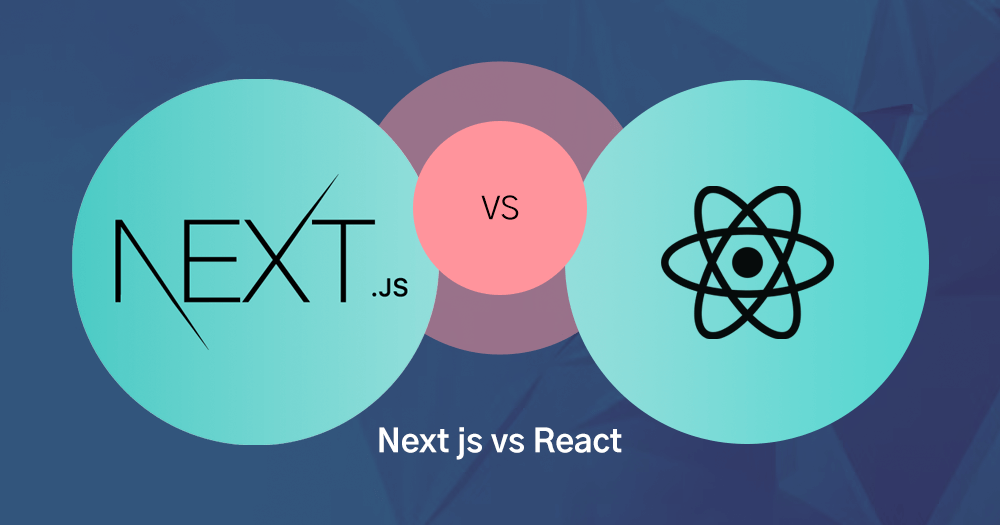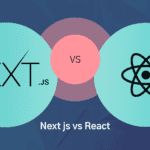In 2024, Next.js and React continue to stand out as leading front-end frameworks. React, developed by Facebook, is a JavaScript library that allows you to build user interfaces using a component-based architecture. On the other hand, Next.js, created by Vercel, extends React’s capabilities with features like server-side rendering (SSR) and static site generation (SSG).
Choosing the right framework for your project is crucial. The decision between Next.js and React can significantly impact your development workflow, performance, and even SEO.
In this article, you’ll learn:
- The core features and origins of both frameworks.
- Pros and cons of using each framework.
- Comparative analysis to help you decide which framework suits your needs in 2024.
Explore how these frameworks stack up against each other to make an informed choice for your next project.
Understanding React
React JS is a JavaScript library created by Facebook in 2013. It’s become essential for building dynamic user interfaces. This library uses a component-based structure, allowing developers to make reusable UI components that boost efficiency and maintainability.
Key Features of React
Virtual DOM
React optimizes rendering by using a virtual representation of the real DOM. Instead of updating the entire DOM whenever changes occur, React updates only the parts that have changed. This results in significant performance improvements.
JSX Syntax
JSX is a syntax extension for JavaScript that allows you to write HTML-like code within your JavaScript files. This makes it easier to visualize the structure of your UI and improves the readability of your code.
One-Way Data Binding
Data flow in React is unidirectional, meaning it moves from parent components to child components. This simplifies the debugging process and makes it easier to track how data changes throughout your application.
React’s strong features have made it a popular choice among developers for creating highly interactive and fast web applications. Its focus on reusing components and updating efficiently continues to make it stand out among front-end development tools.
Advantages and Disadvantages of Using React
Pros
1. Extensive Documentation
React has a lot of documentation that makes it easier to learn. Whether you’re new to programming or an experienced developer, the official React docs have detailed guides, tutorials, and examples to help you get started and understand advanced concepts.
2. High Performance Due to Virtual DOM Efficiency
The virtual DOM is one of React’s standout features. By efficiently updating only the parts of the UI that have changed, React significantly enhances performance. This leads to faster rendering times and a smoother user experience.
3. Large Community Support
With a vast and active community, React offers unparalleled support. You’ll find numerous libraries, tools, and resources created by developers worldwide. Platforms like Stack Overflow, GitHub, and various forums are brimming with solutions to common problems and innovative use cases.
Cons
1. Rapid Development Cycle
React’s fast-paced development can be both good and bad. While it ensures that the library stays up-to-date with the latest advancements, it also means that keeping up with new releases and changes can be challenging for developers.
2. Lack of Built-In Routing Solutions
Unlike some frameworks that come with built-in routing capabilities, React requires you to rely on third-party libraries such as React Router for handling routing. This adds an extra layer of complexity to your projects.
3. Complex Documentation for Beginners
Although extensive documentation is available, its sheer volume can be overwhelming for newcomers. The learning curve may seem steep initially, especially when trying to grasp advanced features without a solid foundation in basic concepts.
Understanding these advantages and disadvantages will help you determine if React aligns with your project needs.
Exploring Next.js Framework
Next.js is a powerful framework built on top of React, designed to enhance its capabilities, particularly for server-side rendering (SSR) and static site generation (SSG). Unlike React, which is primarily a library for building user interfaces, Next.js provides a more comprehensive solution by adding essential features that simplify the development of performant web applications.
Key Features of Next.js:
- Server-Side Rendering (SSR): This feature allows pages to be rendered on the server and sent to the client as fully-rendered HTML. SSR improves SEO and initial page load times, making it an excellent choice for content-heavy websites.
- Static Site Generation (SSG): With SSG, pages are pre-rendered at build time. This approach combines the performance benefits of static sites with the flexibility of dynamic content, offering an optimal solution for blogs, marketing sites, and e-commerce platforms.
- File-Based Routing: Next.js simplifies routing by using the file system to generate routes automatically. Each file in the
pagesdirectory corresponds to a route in the application, which reduces boilerplate code and enhances developer productivity. - Automatic Code Splitting: Only the necessary JavaScript for each page is loaded, which improves performance by reducing the initial load time. This feature ensures that users download only what they need when they need it.
Next.js framework stands out in scenarios where search engine visibility and fast page loads are crucial. By leveraging its built-in SSR and SSG capabilities, developers can create highly optimized applications without sacrificing development speed or complexity.
Advantages and Disadvantages of Using Next.js Framework
Pros
- Better Search Engine Visibility through SSR: By rendering pages on the server before sending them to the client, Next.js improves SEO. This server-side rendering (SSR) ensures that search engines can index your content more effectively.
- Simplified Setup for Server-Rendered Applications: Next.js streamlines the process of creating server-rendered applications. Features like file-based routing and automatic code splitting reduce setup complexity, allowing you to focus more on developing your application rather than configuring it.
Cons
- Increased Complexity Leading to Higher Development Costs: The added capabilities of Next.js come with a steeper learning curve and increased project complexity. This often translates to higher development and maintenance costs.
- Smaller Community Compared to React: Although growing, the Next.js community is not as large as React’s. This may limit readily available resources and support, potentially slowing down problem resolution and learning curves.
Next.js aims to enhance performance optimization techniques while addressing various limitations inherent in using React alone. It’s crucial to weigh these pros and cons based on your project’s specific needs.
Comparing Next.js and React Frameworks
When deciding between React and Next.js, consider your project’s specific needs:
- React: Best for apps with complex routing or heavy client-side rendering. You can easily use various third-party libraries for state management, animations, and routing.
- Next.js: Perfect for SEO-focused projects needing server-side rendering. Its built-in features like file-based routing and automatic code splitting boost performance and make development easier for server-rendered apps.
Choosing the right framework depends on your priorities—whether it’s flexibility with React or built-in optimizations with Next.js.
Making an Informed Choice: Which Framework Should You Choose in 2024?
Evaluating your project needs is crucial when deciding between Next.js and React. Here are the key factors to consider:
- Project Requirements: Assess the complexity of your application. For SEO-focused projects or static site generation, Next.js excels with its built-in SSR and SSG capabilities. For applications with complex routing or dynamic interactions, React provides greater flexibility.
- Performance Needs: If optimal performance and load times are critical, Next.js offers automatic code splitting and optimized resource loading.
- Community and Support: A larger community means more resources. React has a vast ecosystem, while Next.js benefits from being an extension of React but has a smaller community.
- Developer Experience: Consider the development and maintenance complexity. React might be easier for quick iterations due to its simpler setup; however, Next.js can streamline development with its comprehensive feature set.
Choosing between Next JS vs React depends on these considerations to align the framework choice with your project’s goals and constraints.
Conclusion
Choosing the right framework for your project in 2024 depends on understanding your specific needs. Both Next.js and React offer great features and advantages, but they serve different purposes.
When to Use React
React is a great choice for:
- Applications requiring complex UI and dynamic data handling.
- Projects benefiting from a large community and extensive third-party libraries.
When to Use Next.js
Next.js is ideal for:
- SEO-focused projects needing server-side rendering.
- Static site generation with optimized performance.
How to Decide
When deciding between these front-end frameworks, consider the following:
- Project Requirements: Assess whether your project needs advanced routing or enhanced SEO capabilities.
- Development Complexity: Weigh the ease of setup and maintenance against the complexity of features required.
- Community and Support: Factor in the availability of resources, libraries, and community support.
Ultimately, both frameworks offer robust solutions tailored to different development scenarios. By aligning their strengths with your project goals, you can make a well-informed choice between Next JS vs React : Which Framework to choose for front end?
FAQs (Frequently Asked Questions)
What are the main differences between Next.js and React?
Next.js is a framework built on top of React that provides additional features such as server-side rendering (SSR) and static site generation. While React is primarily a JavaScript library for building user interfaces, Next.js enhances its capabilities by offering built-in routing and performance optimizations.
What are the advantages of using React?
React offers several advantages, including extensive documentation, high performance due to its virtual DOM efficiency, and a large community that provides support and resources. However, it also comes with challenges such as a steep learning curve and complex documentation for beginners.
Why should I consider using Next.js for my project?
Next.js is ideal for projects that require better SEO performance due to its server-side rendering capabilities. It simplifies the setup for server-rendered applications and allows for automatic code splitting, which can enhance loading times and overall user experience.
What are the disadvantages of using Next.js?
While Next.js provides many benefits, it also has drawbacks such as increased complexity that can lead to higher development costs. Additionally, its community is smaller compared to React, which may limit available resources and support.
When should I choose React over Next.js?
You should consider using React when your project requires complex routing scenarios or when you want more control over client-side rendering. React is also suitable for applications where SEO is not a primary concern.
How do I decide between Next.js and React for my project in 2024?
To make an informed decision between Next.js and React in 2024, you should consider the specific requirements of your project. If you prioritize SEO and server-side rendering, Next.js might be the better choice. On the other hand, if you value flexibility, control over rendering, and a larger community, React could be the preferred option. It’s essential to evaluate the latest updates and advancements in both frameworks to gauge their relevance and suitability for your project.ke an informed choice between Next.js and React, evaluate your project needs based on factors like SEO requirements, complexity of routing, team expertise, and desired performance optimizations. Understanding these aspects will help you select the right framework for your specific use case.
















